An official website of the United States government
 United States Department of Labor
United States Department of Labor
Operate one or more of a variety of office machines, such as photocopying, photographic, and duplicating machines, or other office machines. Excludes "Billing and Posting Clerks" (43-3021) and "Mail Clerks and Mail Machine Operators, Except Postal Service" (43-9051).
Employment estimate and mean wage estimates for Office Machine Operators, Except Computer:
| Employment (1) | Employment RSE (3) |
Mean hourly wage |
Mean annual wage (2) |
Wage RSE (3) |
|---|---|---|---|---|
| 40,640 | 3.4 % | $ 17.59 | $ 36,580 | 0.6 % |
Percentile wage estimates for Office Machine Operators, Except Computer:
| Percentile | 10% | 25% | 50% (Median) |
75% | 90% |
|---|---|---|---|---|---|
| Hourly Wage | $ 11.83 | $ 13.78 | $ 16.70 | $ 20.01 | $ 24.98 |
| Annual Wage (2) | $ 24,600 | $ 28,670 | $ 34,730 | $ 41,630 | $ 51,960 |
Industries with the highest published employment and wages for Office Machine Operators, Except Computer are provided. For a list of all industries with employment in Office Machine Operators, Except Computer, see the Create Customized Tables function.
Industries with the highest levels of employment in Office Machine Operators, Except Computer:
| Industry | Employment (1) | Percent of industry employment | Hourly mean wage | Annual mean wage (2) |
|---|---|---|---|---|
| Business Support Services | 6,640 | 0.80 | $ 16.65 | $ 34,640 |
| Data Processing, Hosting, and Related Services | 4,510 | 1.26 | $ 16.85 | $ 35,060 |
| Credit Intermediation and Related Activities (5221 and 5223 only) | 2,600 | 0.13 | $ 18.10 | $ 37,650 |
| Insurance Carriers | 2,330 | 0.19 | $ 17.63 | $ 36,680 |
| Employment Services | 1,730 | 0.05 | $ 16.70 | $ 34,730 |
Industries with the highest concentration of employment in Office Machine Operators, Except Computer:
| Industry | Employment (1) | Percent of industry employment | Hourly mean wage | Annual mean wage (2) |
|---|---|---|---|---|
| Data Processing, Hosting, and Related Services | 4,510 | 1.26 | $ 16.85 | $ 35,060 |
| Business Support Services | 6,640 | 0.80 | $ 16.65 | $ 34,640 |
| Printing and Related Support Activities | 960 | 0.25 | $ 18.35 | $ 38,160 |
| Electronic and Precision Equipment Repair and Maintenance | 230 | 0.22 | $ 14.53 | $ 30,230 |
| Insurance Carriers | 2,330 | 0.19 | $ 17.63 | $ 36,680 |
Top paying industries for Office Machine Operators, Except Computer:
| Industry | Employment (1) | Percent of industry employment | Hourly mean wage | Annual mean wage (2) |
|---|---|---|---|---|
| Chemical Manufacturing (3251, 3252, 3253, and 3259 only) | 80 | 0.02 | $ 35.69 | $ 74,230 |
| Merchant Wholesalers, Durable Goods (4232, 4233, 4235, 4236, 4237, and 4239 only) | 70 | (7) | $ 24.75 | $ 51,490 |
| Telecommunications | 130 | 0.02 | $ 23.08 | $ 48,010 |
| Religious Organizations | 40 | 0.02 | $ 22.55 | $ 46,900 |
| Outpatient Care Centers | 150 | 0.02 | $ 22.34 | $ 46,470 |
States and areas with the highest published employment, location quotients, and wages for Office Machine Operators, Except Computer are provided. For a list of all areas with employment in Office Machine Operators, Except Computer, see the Create Customized Tables function.
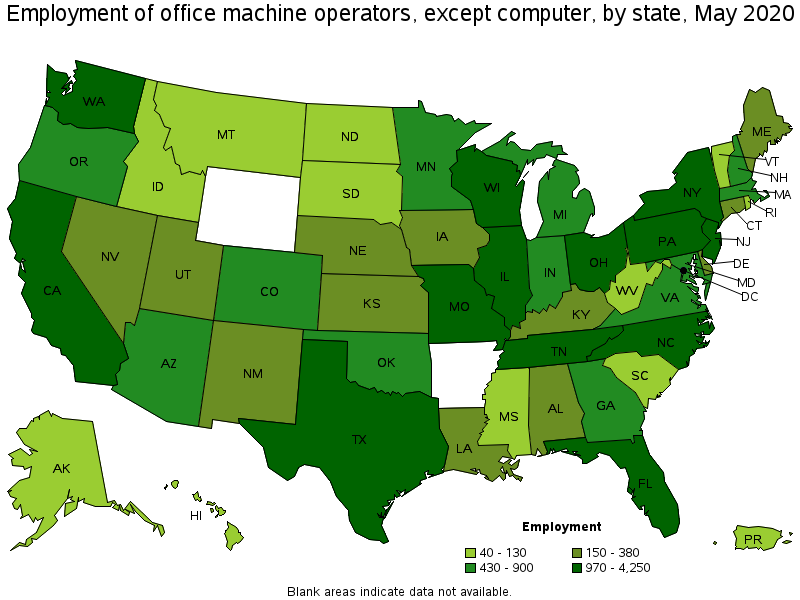
States with the highest employment level in Office Machine Operators, Except Computer:
| State | Employment (1) | Employment per thousand jobs | Location quotient (9) | Hourly mean wage | Annual mean wage (2) |
|---|---|---|---|---|---|
| New York | 4,250 | 0.49 | 1.67 | $ 19.16 | $ 39,850 |
| Texas | 3,770 | 0.31 | 1.07 | $ 17.98 | $ 37,400 |
| California | 3,700 | 0.23 | 0.77 | $ 19.07 | $ 39,660 |
| New Jersey | 2,770 | 0.73 | 2.51 | $ 15.82 | $ 32,900 |
| Ohio | 2,360 | 0.46 | 1.57 | $ 16.35 | $ 34,010 |
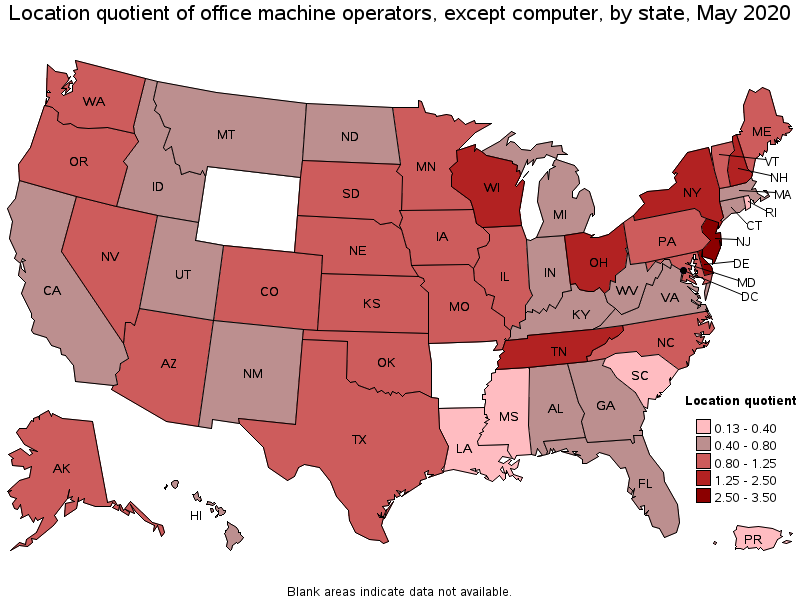
States with the highest concentration of jobs and location quotients in Office Machine Operators, Except Computer:
| State | Employment (1) | Employment per thousand jobs | Location quotient (9) | Hourly mean wage | Annual mean wage (2) |
|---|---|---|---|---|---|
| Delaware | 340 | 0.80 | 2.74 | $ 18.47 | $ 38,410 |
| New Jersey | 2,770 | 0.73 | 2.51 | $ 15.82 | $ 32,900 |
| New Hampshire | 430 | 0.69 | 2.37 | $ 14.71 | $ 30,600 |
| District of Columbia | 380 | 0.55 | 1.88 | $ 20.10 | $ 41,820 |
| New York | 4,250 | 0.49 | 1.67 | $ 19.16 | $ 39,850 |
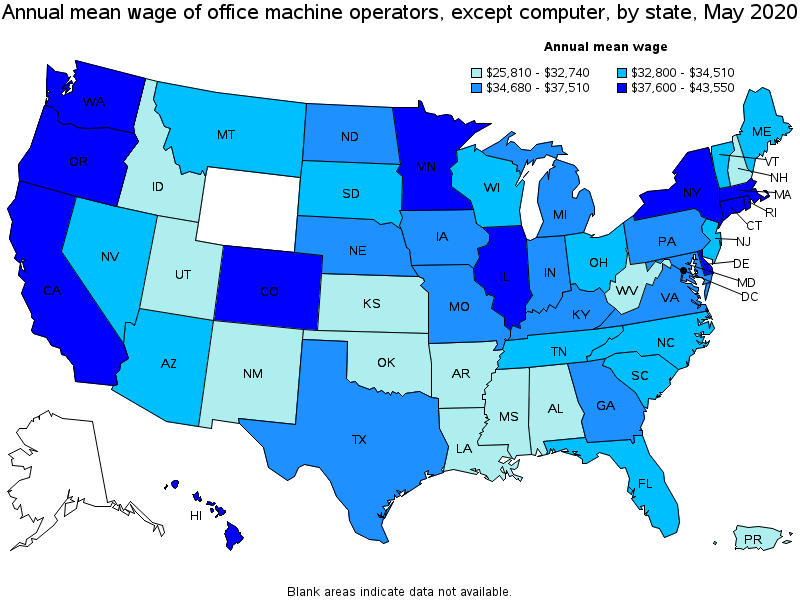
Top paying states for Office Machine Operators, Except Computer:
| State | Employment (1) | Employment per thousand jobs | Location quotient (9) | Hourly mean wage | Annual mean wage (2) |
|---|---|---|---|---|---|
| Connecticut | 330 | 0.21 | 0.73 | $ 20.94 | $ 43,550 |
| Massachusetts | 620 | 0.19 | 0.64 | $ 20.48 | $ 42,600 |
| Oregon | 430 | 0.24 | 0.82 | $ 20.45 | $ 42,530 |
| Rhode Island | 40 | 0.10 | 0.35 | $ 20.25 | $ 42,110 |
| District of Columbia | 380 | 0.55 | 1.88 | $ 20.10 | $ 41,820 |
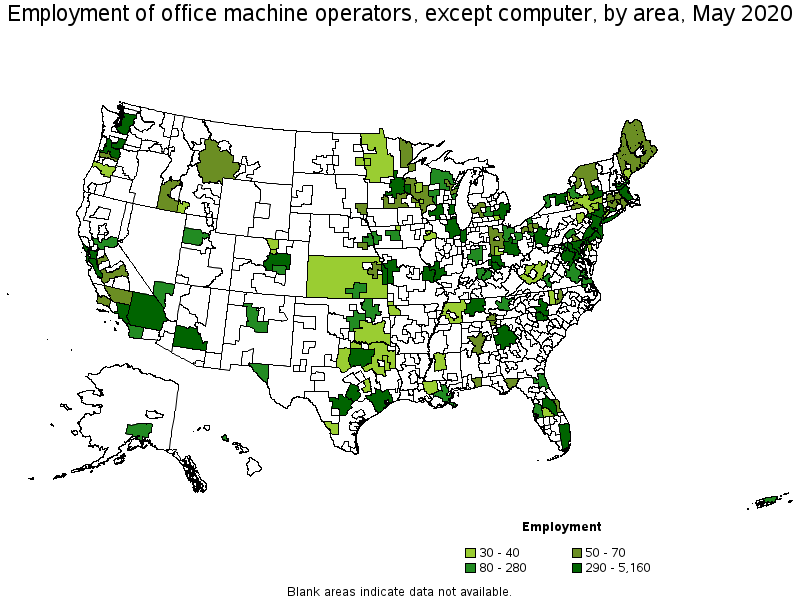
Metropolitan areas with the highest employment level in Office Machine Operators, Except Computer:
| Metropolitan area | Employment (1) | Employment per thousand jobs | Location quotient (9) | Hourly mean wage | Annual mean wage (2) |
|---|---|---|---|---|---|
| New York-Newark-Jersey City, NY-NJ-PA | 5,160 | 0.58 | 2.00 | $ 18.31 | $ 38,080 |
| Dallas-Fort Worth-Arlington, TX | 1,600 | 0.45 | 1.52 | $ 18.48 | $ 38,440 |
| Los Angeles-Long Beach-Anaheim, CA | 1,470 | 0.25 | 0.86 | $ 17.98 | $ 37,390 |
| Philadelphia-Camden-Wilmington, PA-NJ-DE-MD | 1,320 | 0.49 | 1.68 | $ 17.82 | $ 37,070 |
| Chicago-Naperville-Elgin, IL-IN-WI | 1,240 | 0.28 | 0.97 | $ 19.16 | $ 39,860 |
| Columbus, OH | 1,090 | 1.06 | 3.64 | $ 16.05 | $ 33,380 |
| Washington-Arlington-Alexandria, DC-VA-MD-WV | 1,000 | 0.33 | 1.13 | $ 19.34 | $ 40,230 |
| Houston-The Woodlands-Sugar Land, TX | 800 | 0.27 | 0.92 | $ 19.37 | $ 40,290 |
| Boston-Cambridge-Nashua, MA-NH | 660 | 0.25 | 0.87 | $ 19.06 | $ 39,650 |
| Phoenix-Mesa-Scottsdale, AZ | 660 | 0.31 | 1.06 | $ 16.71 | $ 34,760 |
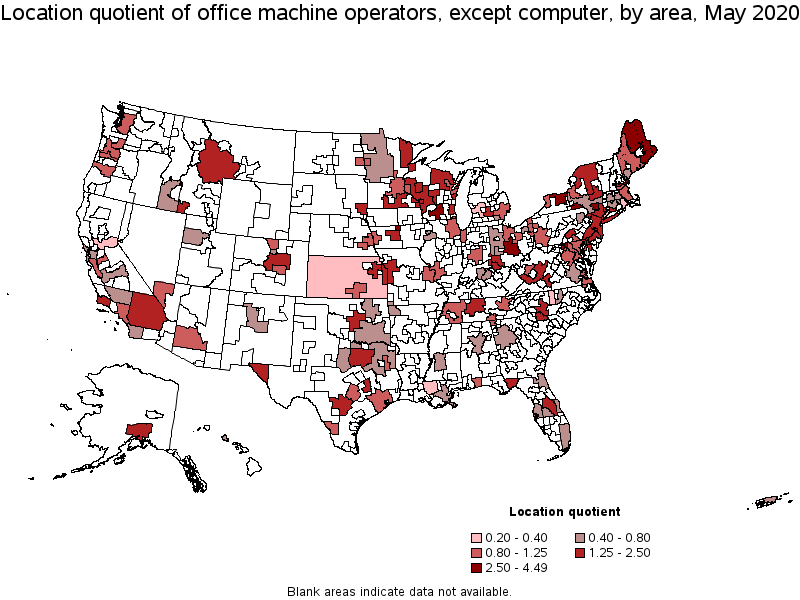
Metropolitan areas with the highest concentration of jobs and location quotients in Office Machine Operators, Except Computer:
| Metropolitan area | Employment (1) | Employment per thousand jobs | Location quotient (9) | Hourly mean wage | Annual mean wage (2) |
|---|---|---|---|---|---|
| Hagerstown-Martinsburg, MD-WV | 130 | 1.31 | 4.49 | $ 15.60 | $ 32,450 |
| Portsmouth, NH-ME | 110 | 1.26 | 4.31 | $ 15.87 | $ 33,010 |
| Columbus, OH | 1,090 | 1.06 | 3.64 | $ 16.05 | $ 33,380 |
| Madison, WI | 380 | 0.99 | 3.40 | $ 13.71 | $ 28,520 |
| Ames, IA | 30 | 0.79 | 2.69 | $ 13.48 | $ 28,040 |
| Rochester, NY | 370 | 0.78 | 2.68 | $ 16.19 | $ 33,680 |
| Binghamton, NY | 70 | 0.78 | 2.67 | $ 16.16 | $ 33,620 |
| Kingston, NY | 40 | 0.75 | 2.57 | $ 15.85 | $ 32,980 |
| Manchester, NH | 80 | 0.72 | 2.46 | $ 13.36 | $ 27,800 |
| Albany-Schenectady-Troy, NY | 290 | 0.70 | 2.40 | $ 15.73 | $ 32,710 |
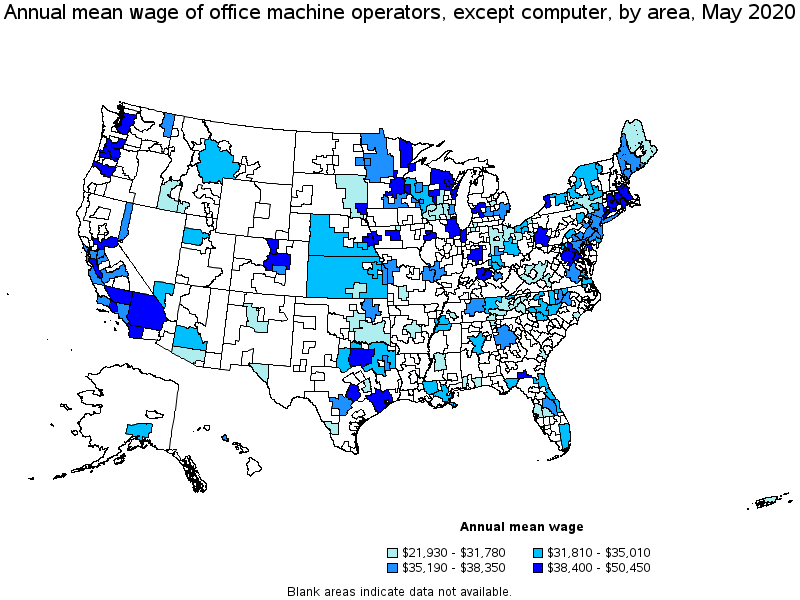
Top paying metropolitan areas for Office Machine Operators, Except Computer:
| Metropolitan area | Employment (1) | Employment per thousand jobs | Location quotient (9) | Hourly mean wage | Annual mean wage (2) |
|---|---|---|---|---|---|
| Hartford-West Hartford-East Hartford, CT | 70 | 0.13 | 0.44 | $ 24.25 | $ 50,450 |
| Salem, OR | 50 | 0.28 | 0.97 | $ 23.69 | $ 49,270 |
| Eugene, OR | 40 | 0.24 | 0.83 | $ 23.26 | $ 48,380 |
| Sacramento--Roseville--Arden-Arcade, CA | 80 | 0.08 | 0.27 | $ 22.49 | $ 46,780 |
| San Jose-Sunnyvale-Santa Clara, CA | 290 | 0.26 | 0.90 | $ 22.12 | $ 46,020 |
| Worcester, MA-CT | 50 | 0.17 | 0.59 | $ 21.51 | $ 44,730 |
| Bridgeport-Stamford-Norwalk, CT | 30 | 0.09 | 0.29 | $ 21.25 | $ 44,190 |
| Fort Collins, CO | 40 | 0.23 | 0.80 | $ 20.77 | $ 43,190 |
| Danbury, CT | 50 | 0.66 | 2.24 | $ 20.71 | $ 43,080 |
| Duluth, MN-WI | 60 | 0.50 | 1.72 | $ 20.50 | $ 42,640 |
Nonmetropolitan areas with the highest employment in Office Machine Operators, Except Computer:
| Nonmetropolitan area | Employment (1) | Employment per thousand jobs | Location quotient (9) | Hourly mean wage | Annual mean wage (2) |
|---|---|---|---|---|---|
| Northeastern Wisconsin nonmetropolitan area | 100 | 0.51 | 1.74 | $ 20.36 | $ 42,350 |
| North Northeastern Ohio nonmetropolitan area (noncontiguous) | 90 | 0.29 | 1.00 | $ 14.33 | $ 29,810 |
| Southeast Minnesota nonmetropolitan area | 60 | 0.41 | 1.42 | $ 17.42 | $ 36,220 |
| Western Wisconsin nonmetropolitan area | 60 | 0.44 | 1.50 | $ 15.95 | $ 33,170 |
| Northeast Maine nonmetropolitan area | 60 | 0.86 | 2.96 | $ 13.09 | $ 27,220 |
Nonmetropolitan areas with the highest concentration of jobs and location quotients in Office Machine Operators, Except Computer:
| Nonmetropolitan area | Employment (1) | Employment per thousand jobs | Location quotient (9) | Hourly mean wage | Annual mean wage (2) |
|---|---|---|---|---|---|
| Northeast Maine nonmetropolitan area | 60 | 0.86 | 2.96 | $ 13.09 | $ 27,220 |
| Southern West Virginia nonmetropolitan area | 40 | 0.52 | 1.77 | $ 14.79 | $ 30,770 |
| Northeastern Wisconsin nonmetropolitan area | 100 | 0.51 | 1.74 | $ 20.36 | $ 42,350 |
| Western Wisconsin nonmetropolitan area | 60 | 0.44 | 1.50 | $ 15.95 | $ 33,170 |
| Southeast Minnesota nonmetropolitan area | 60 | 0.41 | 1.42 | $ 17.42 | $ 36,220 |
Top paying nonmetropolitan areas for Office Machine Operators, Except Computer:
| Nonmetropolitan area | Employment (1) | Employment per thousand jobs | Location quotient (9) | Hourly mean wage | Annual mean wage (2) |
|---|---|---|---|---|---|
| Northeastern Wisconsin nonmetropolitan area | 100 | 0.51 | 1.74 | $ 20.36 | $ 42,350 |
| Northwest Minnesota nonmetropolitan area | 40 | 0.22 | 0.75 | $ 18.38 | $ 38,240 |
| Southwest Maine nonmetropolitan area | 50 | 0.27 | 0.91 | $ 17.66 | $ 36,740 |
| Southeast Minnesota nonmetropolitan area | 60 | 0.41 | 1.42 | $ 17.42 | $ 36,220 |
| Southwest Montana nonmetropolitan area | 50 | 0.39 | 1.32 | $ 16.77 | $ 34,890 |
These estimates are calculated with data collected from employers in all industry sectors, all metropolitan and nonmetropolitan areas, and all states and the District of Columbia. The top employment and wage figures are provided above. The complete list is available in the downloadable XLS files.
The percentile wage estimate is the value of a wage below which a certain percent of workers fall. The median wage is the 50th percentile wage estimate—50 percent of workers earn less than the median and 50 percent of workers earn more than the median. More about percentile wages.
(1) Estimates for detailed occupations do not sum to the totals because the totals include occupations not shown separately. Estimates do not include self-employed workers.
(2) Annual wages have been calculated by multiplying the hourly mean wage by a "year-round, full-time" hours figure of 2,080 hours; for those occupations where there is not an hourly wage published, the annual wage has been directly calculated from the reported survey data.
(3) The relative standard error (RSE) is a measure of the reliability of a survey statistic. The smaller the relative standard error, the more precise the estimate.
(7) The value is less than .005 percent of industry employment.
(9) The location quotient is the ratio of the area concentration of occupational employment to the national average concentration. A location quotient greater than one indicates the occupation has a higher share of employment than average, and a location quotient less than one indicates the occupation is less prevalent in the area than average.
Other OEWS estimates and related information:
May 2020 National Occupational Employment and Wage Estimates
May 2020 State Occupational Employment and Wage Estimates
May 2020 Metropolitan and Nonmetropolitan Area Occupational Employment and Wage Estimates
May 2020 National Industry-Specific Occupational Employment and Wage Estimates
Last Modified Date: March 31, 2021